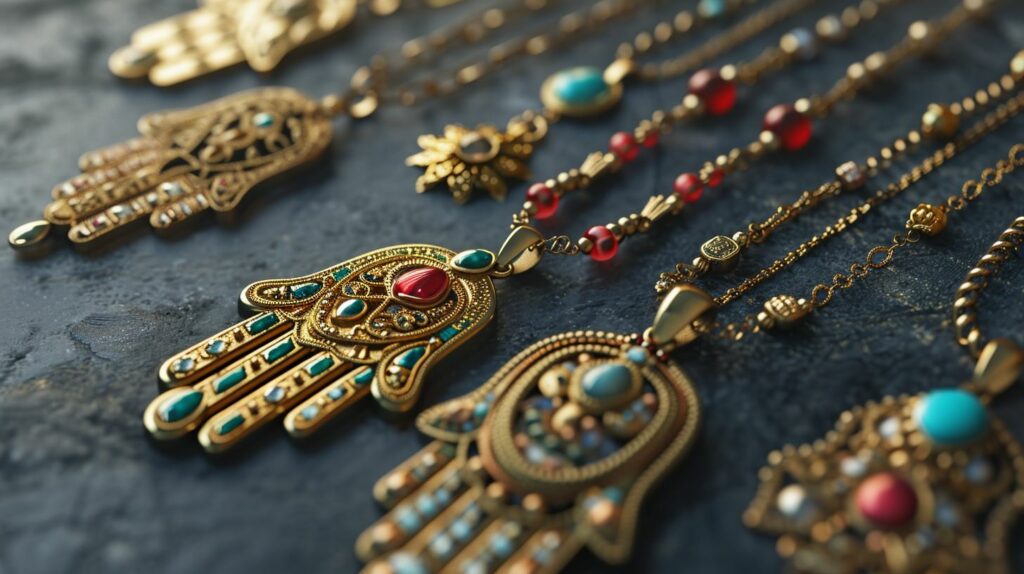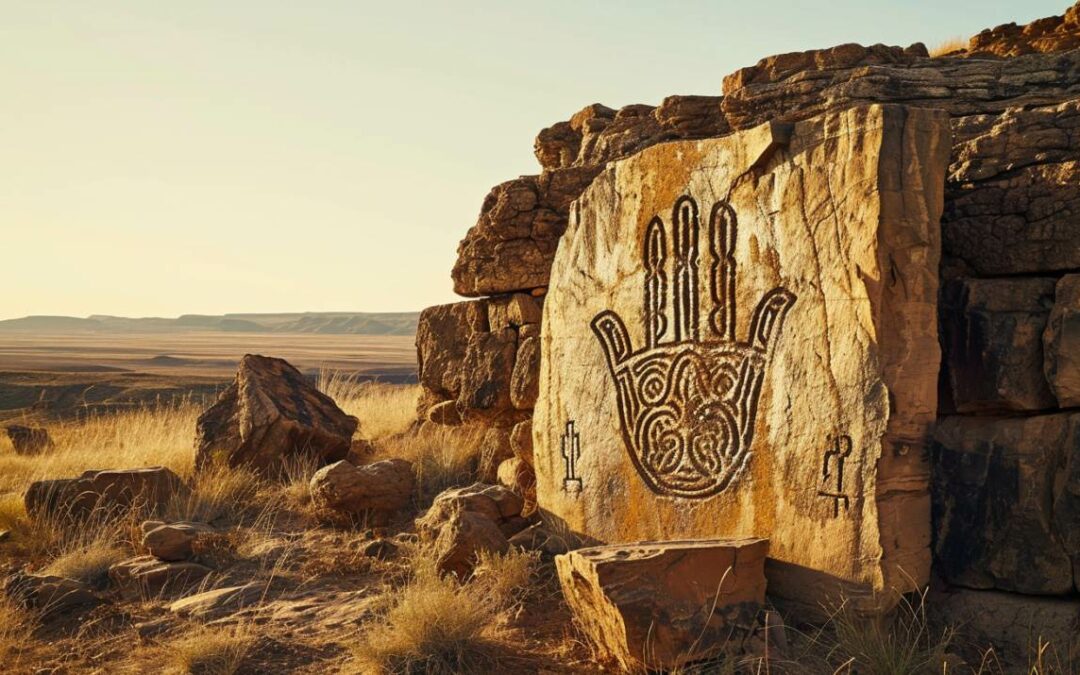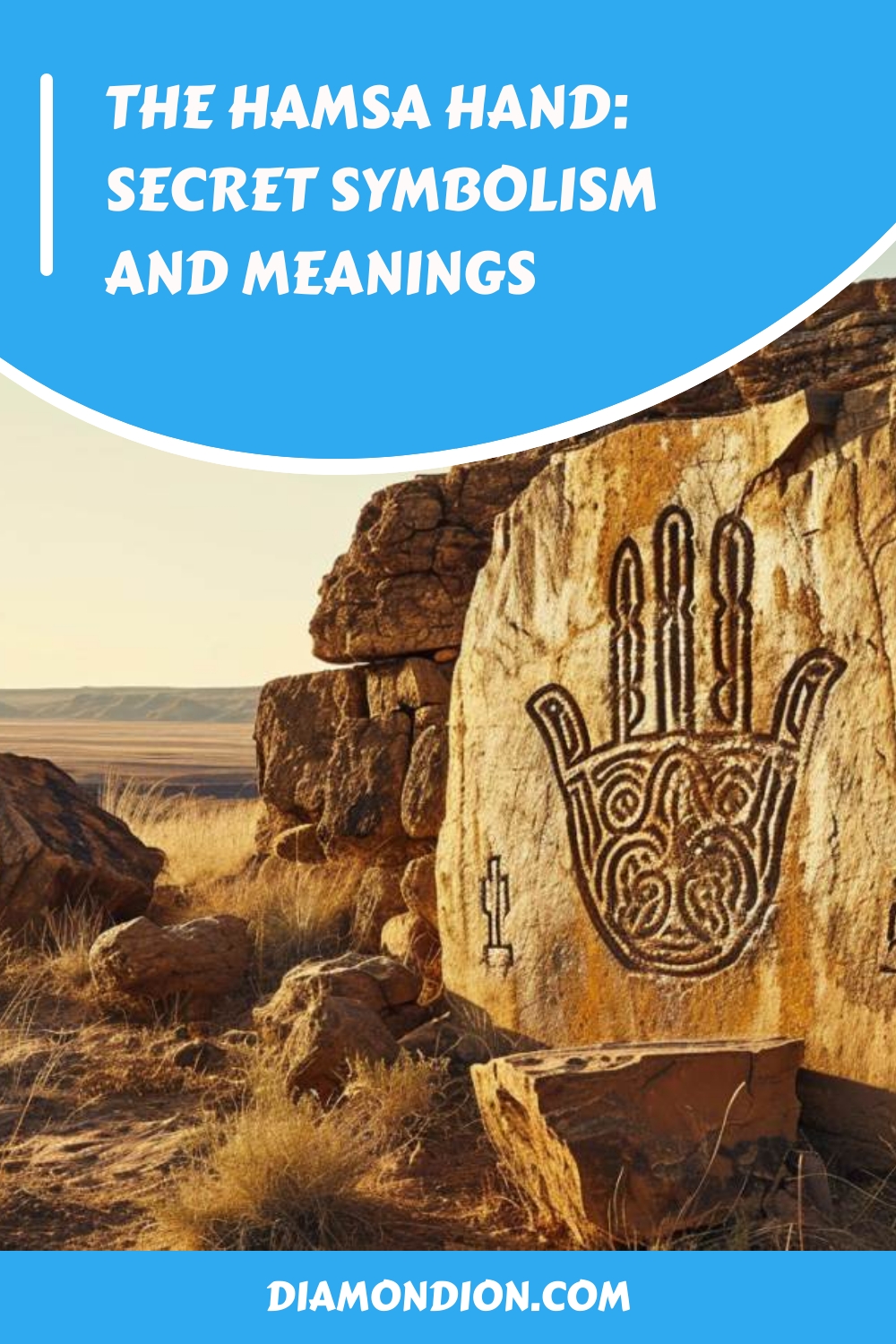Article Contents
- 1 Key Takeaways
- 2 Hamsa Hand Origins
- 3 Cultural Significance of the Hamsa Hand
- 4 Symbolic Interpretations of the Hamsa Hand
- 5 Hamsa Hand’s Religious Connections
- 6 Hamsa Hand’s Protective Properties
- 7 Artistic Representations of The Hamsa Hand
- 8 Modern Usage and Adaptations Of the Hamsa Hand
- 9 Hamsa in Jewelry and Fashion
- 10 Frequently Asked Questions
- 11 Conclusion
- 12 Can Hamsa Hand Symbolism Be Incorporated Into a Custom Engagement Ring Design?
- 13 References Used to Research This Article
The Hamsa Hand, a symbol rich with historical significance, embodies a multitude of meanings that transcend cultural and religious boundaries. This ancient symbol, recognizable by its palm-shaped figure, is frequently associated with protection, acting as a barrier against negative energies and the envious gaze known as the “evil eye.”
Its roots are deeply embedded in Middle Eastern lore, with connections to Islamic, Jewish, and Christian traditions. The Hand of Fatima, as it is also known, represents a protective sign that fosters a sense of peace and freedom among its adherents.
Its widespread adoption and varied interpretations reflect a deep human desire for safety and liberation. As we explore the Hamsa Hand’s symbolism and meanings, we delve into a symbol that continues to resonate with individuals seeking spiritual assurance and autonomy in an ever-changing world.
Key Takeaways
- The Hamsa Hand has origins in ancient civilizations and is associated with protection against the evil eye.
- Both the Jewish and Muslim communities accept it as a part of their shared cultural heritage.
- The Hamsa Hand symbolizes divine protection and favor in Islam and Judaism.
- It serves as a potent symbol of protection, shields against harm, and represents freedom and safety.
Hamsa Hand Origins
Historically, the Hamsa Hand has frequently been linked to ancient civilizations, with archaeological evidence placing its origins as far back as the Phoenicians in the 8th century BCE. This emblem, known for its distinctive palm-shaped design, is replete with cultural connotations and has functioned as a symbol of protection throughout its extensive history. The hamsa hand meaning has evolved, yet consistently it has served as a safeguard against malevolent forces, particularly the evil eye—a pervasive threat in ancient Middle Eastern lore.

The origins of the hamsa are shrouded in antiquity, with ties not only to the Phoenicians but also to Mesopotamian and Carthaginian cultures. It was initially associated with a protective ancient goddess, imbuing the symbol with the hand of fatima meaning—a maternal safeguard against harm. As a talisman, the Hamsa Hand represents a protective mark believed to watch over individuals and grant them freedom from adverse influences.
This symbol has traversed cultural boundaries, accruing additional layers of significance. Its evolution reflects a shared human desire for protection and well-being. The next section will delve into the cultural significance of the Hamsa Hand, exploring its impact across various societies and religions.
Cultural Significance of the Hamsa Hand
We observe the Hamsa Hand as a profound emblem that permeates various cultures, each infusing it with unique spiritual significance and practical applications. The cultural significance of the Hamsa Hand is evident when examining its role within diverse cultures, often serving as a symbol of protection. It is well-liked in both Jewish and Muslim communities, where it is associated with historical figures like Miriam and Fatima, respectively. These connections highlight a shared cultural heritage, tracing back to ancient Mesopotamian civilizations.
The table below encapsulates the Hamsa Hand’s multifaceted cultural presence:
| Culture | Symbolic Representation | Application |
|---|---|---|
| Jewish | Miriam’s hand, liberation | Ketubah decoration |
| Muslim | Hand of Fatima, divine guardian | Amulets for children |
| Ancient Mesopotamian | Fertility, good fortune | Protective talismans |
This analytical exploration reveals that the Hamsa Hand is more than an ornamental figure; it is a beacon of freedom and safety, deeply woven into the social and spiritual fabric of multiple societies. The convergence of interpretations and uses across these cultures showcases the Hamsa Hand’s enduring allure as a universal symbol transcending temporal and geographical boundaries.
Symbolic Interpretations of the Hamsa Hand
In light of its rich cultural tapestry, the Hamsa Hand’s symbolic interpretations vary, each imbuing the symbol with distinct spiritual nuances and protective significance. Given its historical ubiquity across various cultures, the Hamsa Hand’s symbolism has been dissected and analyzed from multiple perspectives.
- Protection Against the Evil Eye: The primary interpretation of the Hamsa Hand is that it offers a shield against the malevolent glare known as the evil eye. This belief is prevalent across numerous cultures, where the symbol acts as a protective amulet.
- Divine Blessing and Presence: It symbolizes the presence of the divine in everyday life. The hand is often seen as a representation of God’s care and is invoked for blessings and favor.
- Unity and Peace: Reflecting its intercultural journey, the Hamsa Hand can symbolize peace and unity among different faiths, promoting a message of coexistence and mutual respect.
- Significance of the Number Five: The number five is embedded in the Hamsa Hand’s very structure and is recurrent in its symbolic interpretations. It represents balance, harmony, and the human experience, being reflected in the five senses and the five digits of the hand itself.
Analytically, the Hamsa Hand serves not just as an amulet but as a cultural nexus, encapsulating a myriad of human desires for freedom from malevolence, the aspiration for divine favor, and the universal quest for peace and understanding.
Hamsa Hand’s Religious Connections
Beyond its general symbolism, the Hamsa Hand holds specific significance within various religious traditions, each attributing unique interpretations to its protective properties. In Islam, the Hand of Fatima is not only a shield against the evil eye but also a reminder of the five pillars of Islam, grounding the symbol in foundational religious principles. This emblem thus serves as a spiritual gesture that embodies both protection and faith.
Within Jewish tradition, the Hamsa is often called the Hand of Miriam, linking it to the sister of Moses and Aaron. Its connection to the Hebrew letter Heh signifies the five books of the Torah, underlining the theme of divine protection embedded within the religion’s sacred texts. The symbol is also associated with the priestly blessing, which is believed to channel divine favor and protection upon the people.
The cross-cultural resonance of the Hamsa Hand demonstrates its role as more than an amulet; it is a symbol deeply entrenched in the spiritual identity of various communities. Its use across different faiths highlights a shared human desire for protection, blessing, and the manifestation of divine benevolence in the material realm.
Hamsa Hand’s Protective Properties
How does the Hamsa Hand function as a guardian against harm and misfortune? Regarded as a potent symbol, the Hamsa Hand is attributed with significant protective properties. The hand acts as a shield, providing a spiritual barrier against various forms of negativity. This safeguarding role is articulated through several key aspects:
- Protection from Evil: The Hamsa Hand is primarily recognized as a powerful deterrent against the malevolent influence of the evil eye, which is believed to be a malicious gaze that can bring about misfortune or injury.
- Warding Off the Evil: By acting as a repellent, the Hamsa amulet is said to intercept and deflect the harmful intentions directed towards an individual.
- Defensive Talisman: As a symbol carried or displayed, the Hamsa serves as a constant guardian, preventing evil forces from penetrating the personal space of the bearer.
- Symbolic Barrier: The open hand symbolizes an impenetrable barrier against negative energies, ensuring peace and security for those who embrace its presence.
These facets of the Hamsa Hand contribute to its reputation as an emblem of spiritual defense, promoting a sense of freedom from the fears of malevolent forces.
Transitioning from the theme of protection, one can also appreciate the Hamsa Hand’s influence in artistic representations, where its aesthetic elements further enrich its symbolic potency.
Artistic Representations of The Hamsa Hand
The artistic depictions of the Hamsa Hand vary across cultures, often incorporating intricate designs and symbolic motifs that enhance its protective meaning. The hand symbol, frequently rendered in the form of hamsa jewelry, serves not only as a talisman but also as an aesthetic expression of cultural identity and religious belief. It is common to find the eye in the middle of the Hamsa, representing vigilance and reflecting negative energy back to its source.
Artistic representations of the Hamsa evoke a sense of divine presence and intervention. In Jewish art, it is emblematic of God’s hand reaching down from the heavens, a motif that echoes the guidance and deliverance provided throughout history. During the Byzantine period, artists depicted this hand symbol leading the Jewish people out of struggle, reinforcing the Hamsa’s association with support and protection.
While the basic form of the Hamsa remains consistent, the diversity of artistic interpretations highlights its adaptability and the deep resonance it holds within various communities. The hamsa symbol has thus transcended its origins to become a universal sign of safeguarding and hope.
As we explore the Hamsa’s presence in contemporary culture, we will delve into its modern usage and adaptations.
Modern Usage and Adaptations Of the Hamsa Hand
Although traditionally rooted in ancient cultures, the Hamsa Hand has found its way into contemporary society, where it is integrated into fashion, art, and intercultural exchange. The modern usage and adaptations of this ancient motif are varied and pervasive, indicating its evolution into a common symbol that transcends its original cultural confines.
Here is an analytical overview of its contemporary use:
- Intercultural Symbolism: The Hamsa Hand has been widely adopted as a symbol of peace and hope, particularly in Middle Eastern conflict zones, promoting a message of coexistence.
- Fashion Statements: It is a staple in jewelry design, where it has been embraced for both its aesthetic appeal and symbolic significance, becoming a widely used adornment.
- Protective Amulets: In Moroccan culture, the Hamsa is still used in rituals and as a talisman to ward off negativity, retaining its traditional protective role.
- National Iconography: In Israel, the Hamsa has been adopted as a symbol of national identity, appearing on an array of everyday items.
As we explore the ways in which the Hamsa Hand has been adopted and adapted, it is clear that its role in jewelry and fashion is particularly significant. There has been a resurgence of interest in the Hamsa Hand within popular culture, leading to its incorporation into various jewelry designs, from necklaces to bracelets. However, as the demand for Hamsa Hand jewelry continues to grow, ethical concerns have arisen regarding cultural appropriation and the importance of respecting the symbol’s origins and meaning. It is important for jewelry designers and consumers alike to consider the ethical implications of incorporating culturally significant symbols into fashion and to ensure that they are doing so in a respectful and informed manner.
Hamsa in Jewelry and Fashion
In contemporary fashion, the Hamsa Hand has emerged as both a stylish accessory and a cultural emblem, reflecting its historical significance while appealing to modern aesthetics. Its integration into jewelry designs encapsulates a blend of spiritual heritage and contemporary taste. Jewelry pieces such as pendants, bracelets, and earrings frequently incorporate the Hamsa Hand, crafted from a variety of materials including gold, sterling silver, pearls, and semi-precious stones. These adornments are not merely decorative; they carry the weight of centuries-old traditions, symbolizing protection and the warding off of negative energies.
The presence of the Hamsa Hand in fashion transcends mere ornamentation. It functions as an amulet, a poignant reminder of the human yearning for safety and well-being. When given as gifts, these items frequently come with a card explaining the Hamsa prayer, which strengthens the talisman’s protective intent. The Hamsa Hand’s aesthetic charm and its reputed power to shield its wearer make it a desirable element in the fashion industry. Consequently, it fosters a connection between the desire for self-expression and the profound human need for security, thus resonating deeply with individuals who value freedom.
Frequently Asked Questions
What Does the Bible Say About the Hamsa Hand?
The Bible does not specifically mention the Hamsa Hand. Thus, it lacks direct scriptural references to this symbol. Any connection to biblical concepts would be interpretative rather than based on explicit biblical texts.
It is essential for those seeking theological guidance to differentiate between cultural symbols and scriptural mandates. Focusing on the latter for clear direction in matters of faith and spiritual symbolism.
What Religion Is the Hand of Hamsa?
The Hand of Hamsa is not exclusive to a single religion but is prevalent across various faiths. It is deeply embedded in Islamic, Jewish, and Christian traditions, serving as a protective emblem and a symbol of divine guardianship.
Its usage transcends religious boundaries, reflecting a shared human desire for safety and blessing. As a cultural artifact, it also holds significance beyond religious contexts, often embodying a universal hope for peace and good fortune.
Should Hamsa Hand Be up or Down?
The orientation of the Hamsa Hand, either facing upwards or downwards, does not adhere to a universal standard and is subject to individual preference. While some interpret the upward position as a shield against negative influences, others regard the downward orientation as an invitation for abundance and blessings.
This variability underscores the symbol’s adaptability across different cultural and personal paradigms, offering a versatile tool for those seeking either protection or fortune.
What Is the Difference Between the Evil Eye and the Hamsa?
As the adage goes, ‘An ounce of prevention is worth a pound of cure,’ distinguishing between the evil eye and the Hamsa is crucial.
The evil eye represents a curse believed to bring harm, while the Hamsa symbolizes protection against such negative influences.
Analytically, the Hamsa serves as a talismanic shield for those seeking freedom from the malevolent gaze, embodying the preventative measures against the adversities ascribed to the evil eye.
Conclusion
In summation, the Hamsa Hand emerges as a potent emblem that transcends cultural and religious boundaries, embodying a plethora of meanings, from protection to blessings. Its widespread adoption and adaptation in various forms, from jewelry to art, underscore its enduring appeal and multifunctional role as a symbol of safeguarding and spiritual fortitude.
This cross-cultural amulet highlights the human proclivity for symbols that offer a sense of security and connection to the transcendent.
Can Hamsa Hand Symbolism Be Incorporated Into a Custom Engagement Ring Design?
The Hamsa hand’s rich symbolism of protection, blessings, and unity can beautifully enhance a custom engagement ring. By incorporating its intricate design elements, the ring becomes a meaningful piece that represents love, harmony, and safeguarding the bond shared by two people, combining personal expression with deep-rooted cultural significance.
References Used to Research This Article
1: https://jewishgiftplace.com/pages/the-hamsa-hand-meaning-the-hand-of-god-hand-of-fatima
2: https://en.wikipedia.org/wiki/Hamsa
3: https://www.mindbodygreen.com/articles/hamsa-meaning
4: https://study.com/academy/lesson/hamsa-history-symbol-facts-hand-fatima.html
5: https://www.karmaandluck.com/blogs/news/hamsa-hand-meaning



